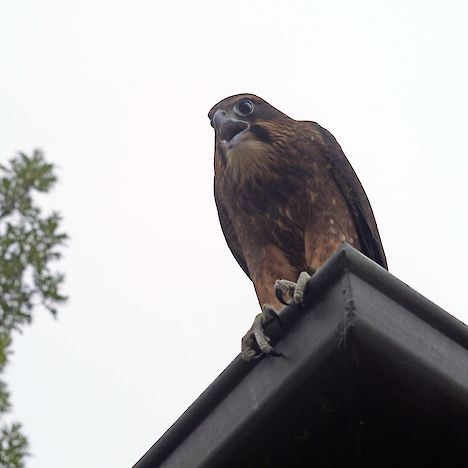Other names:
Kārearea, bush falcon, eastern falcon, southern falconThreat category:
Threatened: Nationally Vulnerable, At Risk: Recovering?Regions:
Auckland, Waikato, Bay of Plenty, Gisborne, Hawkes Bay, Manawatu-Wanganui, Taranaki, Wellington, Nelson-Tasman, Marlborough, Westcoast, Canterbury, Otago, SouthlandDistribution:
Throughout most of New Zealand
Identification
- The New Zealand falcon differs from the Australasian harrier by:
- Being about half the size.
- Having angular wings.
- Being a fast flier with rapid wing beats (as opposed to the gliding of harriers).
- Falcon also rarely feed on carrion, unlike the Australasian harrier, preferring to catch live prey, particularly birds.
Taxonomy
- Two subspecies and one form are presently recognised, based on recent genetic analyses:
- Bush falcon Falco novaeseelandiae ferox, classified as At Risk: Recovering, found in the forests of the North Island and north-western South Island.
- Eastern falcon Falco novaeseelandiae novaeseelandiae, classified as At Risk: Recovering, found in South Island, open country east of Southern Alps.
- Southern falcon Falco novaeseelandiae “southern”, classified as Threatened: Nationally Vulnerable, found in Fiordland, Stewart Island and Auckland Islands.
Interesting Facts
- Widespread in forest and open country throughout New Zealand (except Northland).
- A simple nest is built on the ground, under logs, in trees, on rock faces etc.
- Breeding and chick rearing occurs from September to February.
- Nest areas are easily located by the presence of “dive-bombing” parents usually occurring within 50 m of nest.
- Uses feet to strike birds in mid air or prey on the ground. The most common prey are birds.
Association with Plantations
- It is thought that the relatively recent colonisation of pine plantations by falcons may be due to the widespread use of 1080 for pine plantation pest control.
- Falcons often nest on the ground in young pine forest.
- Common in clearcut and young re-established stands (up to age 4). Once stands develop thick canopies or dense understories, falcon appear to move elsewhere.
- Nests are often located in recently clearfelled sites (up to age 2).
- A mosaic of stand ages and vegetation cover provides the greatest range of prey species.
Threats
- Predation of eggs, young and occasionally adult falcon by cats, mustelids, possums and rats.
- Disturbance of nest sites.
- Deliberate shooting.
- The use of 1080 has been suggested to be a threat to falcons. Research in Kaingaroa Forest suggests, however, that the benefits of the use of 1080 (indirect mustelid and cat control, and greater abundances of bird prey) outweigh possible negatives. Nevertheless, caution should be exercised in the use of 1080 and other poisons in areas of falcon habitat.
Management Options and Methods
- Pest control around nests:
- Either use 1080 to target possums and rats with secondary killing of mustelids and cats, or
- Consider options for integrated pest management - use cyanide for possums, Fenn traps for mustelids, and other kill traps for cats.
- Keep residual trap catch (RTC) of possums to less than 5%.
- Forest operations:
- Avoid any operations around nest sites.
- Injured or dead birds:
- Place injured birds in a cardboard box, keep in the shade and deliver to a vet, SPCA, DOC, or Wingspan.
- Call DOC or Wingspan if bird has a band, or bird is dead.
Monitoring Options
- Increase staff and contractor knowledge about falcons and develop a system to identify nesting sites for temporary avoidance.
- Look for falcon in likely areas.
- Keep a record of sightings, nest locations and breeding outcomes.
- Provide falcon information to Wingspan at www.wingspan.co.nz/Falcon_sightings
Further Information and Support
- New Zealand Birds Online.
- Recognising Karearea.
- Falcon biology, monitoring: www.wingspan.co.nz or email [Enable JavaScript to view protected content].
- Department of Conservation species account: New Zealand falcon.
- New Zealand Falcon Management Guide: Plantation Forestry.
- Pest management - DOC, Regional Councils.
- Extensive research has been carried out and is ongoing on falcons in plantation forests e.g. Seaton, PhD thesis: The Ecological Requirements of the New Zealand Falcon in Plantation Forestry.
- Trewick S.A. and Olley L. 2016: Spatial size dimorphism in New Zealand’s last endemic raptor, the Kārearea Falco novaeseelandiae, coincides with a narrow sea strait. Ibis 158: 747–761.




